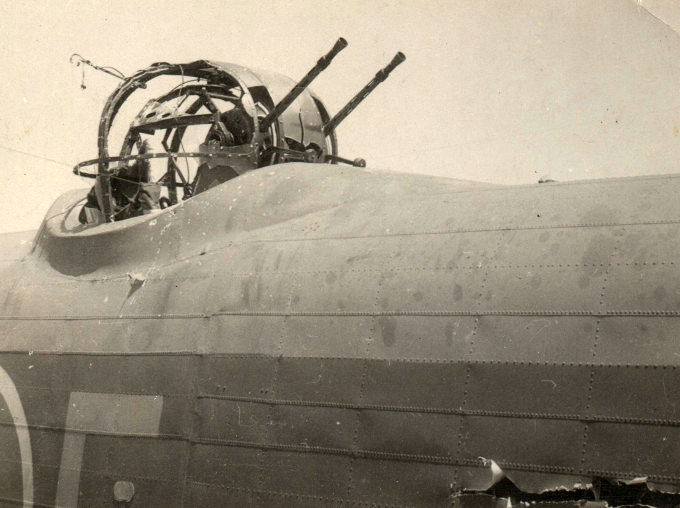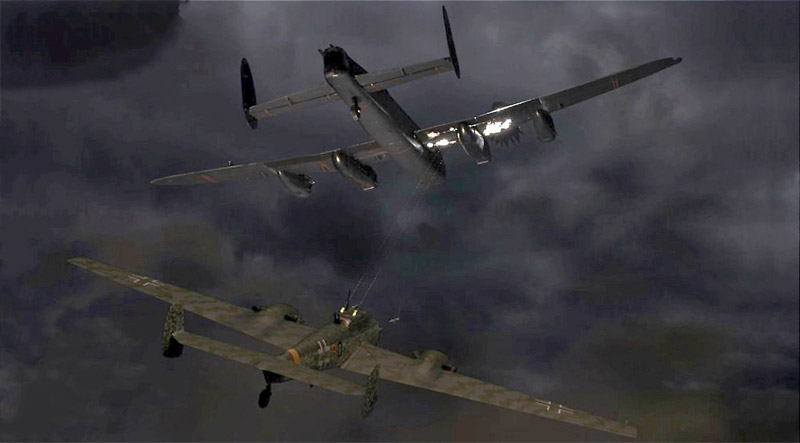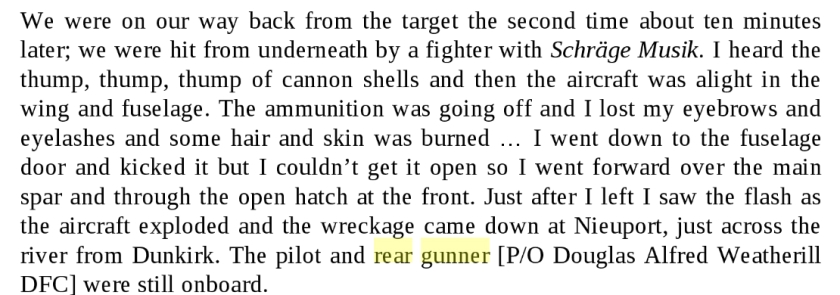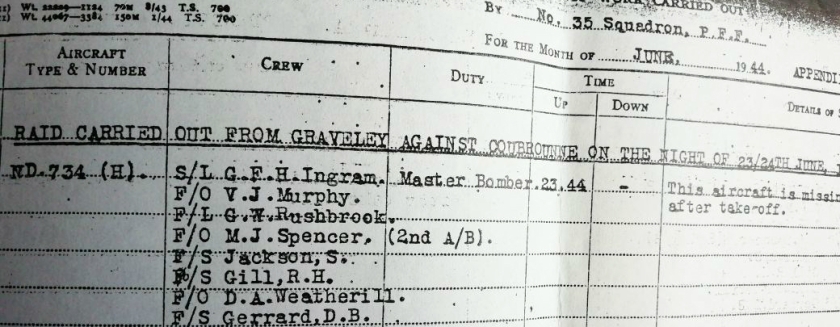Night of the 23/24th June 1944
The rough location of the V-1 Launch Site at Coubronne, Ecques part of the Pas de Calais area in France. Wing Commander A J L Craig 7th Squadron Oakington returned to the Role of Master Bomber on an Operation to Coubronne (V1 Flying Bomb Site Target)
The Route was Bradwell (Derbyshire), North Foreland (Kent Coast), Lattice B 10.65 (Eastern Chain – Gee Lattice Chart), Target, 5045N 0228E, 5105N 0230E, Orford Ness (Suffolk Coast).

No.35 Squadron’s Operations Record Book shows: “Lancaster NG916, TL-F Captained by G A Marsden was attacked by an Enemy Fighter, the 2-Air Gunners being dangerously wounded by Cannon & Machine Gun fire. Attacked by Enemy Fighter over the Coubronne Target area, Sgt Furner & Sgt Farley, both seriously wounded. The former received wound in left eye, right thigh, right shoulder, hand & arm and left forearm. The latter received wounds of left thigh and a compound fracture of right humerus. They were both transferred to RAF Hospital, Ely.
AM Form 78 – The movement card shows that the Lancaster was classified as FB/AC; it was repaired on Site and returned to the Squadron on 22nd July 1944.
Recalling the Night he was Shot-down Bob said: ‘On the Night I was Captured, we were Flying over the Belgian Coast near a place called Nieuwpoort, only about 5-mins from the English Coast. ‘As ‘Pathfinders‘ our Job was to Mark & Light-up the Target for the other Bombers then Circle until the Raid was over. ‘After over 40-Flights in the Tail, I was Flying as a Mid-upper Gunner. ‘Our Pilot (George F H Ingram) decided to go back & take another look, he Circled a couple times and we were Attacked. ‘German Fighters would Fly underneath our 4-Engine Bombers knowing that we had no downward visibility from inside the Planes, then Fire into the Port Wing to hit the Petrol Tanks & Hydraulics (Schrage Musik).

German Schräge Musik Hunters – (18/19th April 1944 French Railway Yards)
A number of Bf-110 (Me-110) G-4 Crews of III./NJG1 left Laon-Athies Air Base at around 22.40-50hrs. Hunting for the Tergnier Force on their return Track, the Gruppenkommandeur Oblt Drewes dispatched 2-Halifaxes between Rouen & Dieppe. Fw. Erich Handke, his Funker (Radio Operator), recalled, – ‘We took-off for a Wilde Sau Sortie (Wild Boar-free ranging) and Flew a long way to the West to get into the returning Tergnier Raiders near St Quentin. We simply flew without any Ground Information towards the Target Markers until I gained a single Contact heading West. We had to Climb to 5,000M before we slowly caught up. At 500M Range Drewes saw the Enemy. As it was on a Homeward Course, he Fired into the Fuselage with the Schräge Weapons and wiggled the Rudder a bit as he did so, at which the Lancaster immediately caught Fire in the Fuselage and both Wings. It then went down in Great Spirals with a monstrous shower of Sparks (2-300M) Trailing behind, which looked like a Comet. It crashed North East of Rouen (Northern France). In the meantime I’d gained more Contacts. We pursued one, and Drewes again saw the Enemy at a Range of 500M. At first it looked like a Lancaster, but to Judge by the Tail it must have been a new Halifax. After a Burst from 50M Below it was Burning as nicely as the previous one and went down immediately, South West of Dieppe. I then gained a lot of Contacts which were already out over the Sea, but they were all going very quickly whilst losing height. We were now only 2,500M up. If we had been able to catch up to them at all, it would only have been at the English Coast, in the Light Ack-Ack Belt. As our Radar could under no circumstances be allowed to fall into Enemy Hands, we were only permitted to chase the English to our own Coast. In addition, we also didn’t have a single Life-Vest with us. As a result, we Flew 30-km Inland, against the remaining Home-bound Bombers, then turned in behind them, however we were soon over the Sea again, barely catching them up, and only 1,500M up. As the Return Flights had just ended, we gave up and Flew Home. Behind us another Attack on Rouen had started, but we had too little Fuel to be able to do anything more.’
The Crew returned to Laon-Athies Air Base at 01.22 hrs. Both Abschüsse (Shootings) were Officially Anerkannt (recognised) on 6th July 1944.

‘The Rear Gunner’s heavy Turret Door was trapped by the Air Pressure and he, along with the Pilot was Killed. ‘I struggled along the Aircraft’s narrow Gangway to the front of the Plane, with flames behind me. ‘As I put my feet out of the Hatch, my Flying Boots went. I landed in a Field on the edge of Nieupoort. The Plane Exploded & Crashed into the River Estuary near Dunkerque.’ Climbing over a Fence on his way to the Road, Bob realised he was still in trouble. ‘I saw a couple of notices with ‘Achtung Minen’ printed on them and realised I had Landed in a Minefield!’
Airmen who became PoWs 1st went to Dulag Luft Transit Camp near Frankfurt, where they were Interrogated for Information, and then to a Permanent Camp. The Journey between Camps often offered the best chance for an Escape. Conditions for PoWs were harsh. Food was always scarce and of poor quality, Camps were cold in Winter & often Overcrowded. They were sustained by Parcels of Food, Medicine & other comforts sent by the Red Cross. Almost 10,000 Aircrew from Bomber Command became PoWs.
Captured, Bob was taken to Frankfurt to be Interrogated and then transferred to the notorious Stalag Luft 7 PoW Camp near Krakow in Poland. With Russia’s Red Army Advancing, Bob and over 1,000 other PoWs were Forced on the ‘Long March‘, a bitter 3-week Forced March in deep Ssnow to another Camp, Luckenwalde, close to Berlin. Many died. This Camp was finally Liberated by Russian Tanks and Bob was helped to Escape by passing Americans who took him to their Base where he was ‘Sprayed with DDT to kill off the Lice living cosily under my Arms & Nether Regions’.
Lancaster ND734 TL-H was one of 16 – 35 Squadron Aircraft detailed to attack Rocket Bases at Coubronne on the Night of the 23rd/24th June 1944. Its 8-man Crew comprised:
S/L George F H Ingram DFC (Pilot) went down with his strichen Aircraft TL-H
Rear Gunner F/O Douglas Alfred Weatherill DFC – KIA Trapped in Rear Turret.
The 6 Remaining Aircrew Members who Abandoned TL-H were taken Prisoners
F/S Douglas Belmont Gerrard – Flight Engineer
F/O Vincent John Murphy – Navigator
F/L George William Rushbrook – Air Bomber
F/O Maurice John Spencer – 2nd Air Bomber
F/S Stephen Jackson – Wireless Operator
F/S Robert Henry James Gill – Upper Gunner
Squadron Leader George Francis Henry Ingram (116714), RAFVR
1658 Conversion Unit, RAF Riccall 9th February 1944
The Halifax Conversion Unit of 76 & 78 moved into Riccall in the September of 1942 in October they formally merged to form 1658 Heavy Conversion Unit (HCU) and in the November they were joined by 158 Conversion Unit which reformed a C Flight 1658, this addition brought the unit up to Full Strength – 32 Halifax Aircraft.
Acting Flight Lieutenant George Francis Henry Ingram DFC, 10th August 1943 102 Squadron
Son of Frederick George Hubert Ingram, and of Elizabeth Anne Ingram, of Bungay, Suffolk. Died aged 22. Likely Crew on this Raid:-
- S/L George Francis Henry Ingram, DFC (Pilot) – 22 Sorties with 35 Squadron from 9th February 1944
- F/O Vincent John Murphy (Navigator) – 22 Sorties with S/L G F H Ingram
- F/L George William Rushbrook (Bomb Aimer) – 22 Sorties with S/L Ingram
- F/O Maurice John Spencer (2nd Bomb Aimer) – 7 Sorties with S/L Ingram
- S Jackson (Wireless Operator) – 22 Sorties with S/L G F H Ingram
- R H J Gill (Mid-upper Gunner, DFM) –
42 Sorties with Flt/Sgt Archie Vernon Hardy RCAF 158 & 35 Sqdns
6 Sorties with S/L George F H Ingram 35 Squadron - Douglas Alfred Weatherill DFC (Rear Gunner) – 22 Sorties with S/L Ingram
- Douglas Belmont Gerrard (Flight Engineer) – 20 Sorties with S/L Ingram

The Route was: Bradwell, North Foreland, Lattice B 10.65 (Eastern Chain), Target, 5045N 0228E, 5105N 0230E, Orford Ness. ND734 failed to return and the Squadron’s Operations Record Book (ORB) shows “This Aircraft is missing, nothing being heard from it after Take-off”
Wartime Activities Relating to the Loss
On 24th June 1944 – 35 Squadron informed Bomber Command, the Air Ministry and the RAF Records Office that the TL-H Aircraft & Crew were Missing. A Telegram, along with a follow-up Letter from the Commanding Officer, was sent to the next of Kin of each Crew Member advising them that he was “missing as the result of Air Operations on 23rd/24th June 1944”. The Crew’s Kit & Personal belongings were removed from their Lockers & catalogued; Kit was returned to the Station Stores & Personal Belongings sent to the Central Depository at RAF Colnbrook.
The Air Ministry Casualty Branch, which was responsible for Investigating, Monitoring & Reporting on the Status of Missing Aircraft & Airmen, subsequently published the following information regarding the Crew:
- Air Ministry Casualty Communique No.435 (Flight 19th October 1944) reported S/L George Francis Henry Ingram DFC & Douglas Alfred Weatherill DFC as “Missing”
- Air Ministry Casualty Communique No.556 (Flight 27th December 1945) reported G F H Ingram & D A Weatherill “previously reported Missing” as “now presumed Killed in Action” (KIA)
Note: Presumption of Death enabled a Death Certificate to be issued; Personal Belongings could then be sent to next of Kin, along with any Monies due.
No.35 Squadron’s Operations Record Book (ORB) shows the following Information was received relating to the Crew:-
- 28/07/1944: Information received from the Air Ministry that V J Murphy, Missing on 23rd / 24th June 1944, was Killed
- 22/08/1944: Information received from the Air Ministry that V J Murphy, Missing on 23rd / 24th June 1944, was not dead, but a Prisoner of War
- 15/09/1944: Information received from the Air Ministry that V J Murphy, G W Rushbrook, S Jackson, R H J Gill & D B Gerrard, Missing on 23rd/24th June 1944, are Prisoners of War
- 30/10/1944: Information received from the Air Ministry that M J Spencer, missing on 23rd / 24th June 1944, is a Prisoner of War
Crew Members who Survived the Crash & Captured / Imprisoned
V J Murphy, G W Rushbrook, M J Spencer, S Jackson, R H J Gill & D B Gerrard Survived the Crash and were Captured, Interrogated & Iimprisoned for the remainder of the War.
Stalag Luft was short for Kriegsgefangenen-Mannschafts-Stammlager– Luft.
These were the same as the Standard ‘Army’ Stalags, however, there is a great deal of evidence that Stalag Lufts were far better Guarded than the normal Camps in recognition of how valuable each Aircrew (especially Pilots) were to the Allie’ War Effort.
Stalag Luft Camps were administered by the Luftwaffe (German Air Force) rather than all other Camps which were administered by the Wehrmacht (Germany Regular Army), the Luftwaffe used their designations so it is a little confusing that whilst Stalags were for Enlisted Men under Army Designation and Oflags for Officers it would logically be named an ‘Oflag Luft‘ since most Aircrews were Officer Ranks.
Their PoW Liberation Questionnaires, which were completed as part of the Repatriation Process at 106 Personnel Reception Centre (RAF Cosford) in 1945, show the following details:-
- V J Murphy (POW Liberation Questionnaire yet to be obtained, so information is unconfirmed)
- Captured:
- Imprisoned: Stalag Luft III, Sagan
- Repatriated:
- G W Rushbrook
- Captured Nr Dixmude 24th June 1944
- Imprisoned: Stalag Luft III, Sagan Jul-44 to Jan-45
- Imprisoned: Marlag Nord, Tarmstedt Feb-45 to Apr-45
- Repatriated: May-45
- M J Spencer
- Captured: Nr Ostende 24th June 1944 (Fractured Arm)
- Hospitalised: St Gilles, Brussels June-44 to August-44
- Imprisoned: Stalag Luft III, Sagan Sep-44 to Feb-45
- Imprisoned: Stalag XIII-D, Nürnberg Feb 45 to May-45
- Repatriated: May-45
- S Jackson
- Captured: Nieupoort 24th June 1944
- Imprisoned: Stalag Luft VII, Bankau Jul-44 to Jan-45
- Imprisoned: Stalag IIIA, Luckenwalde Feb-45 to May-45
- Repatriated: May-45
- R H J Gill
- Captured Ostend 24th June 1944
- Imprisoned: Stalag Luft VII, Bankau Jul-44 to Jan-45
- Imprisoned: Stalag IIIA, Luckenwalde Feb-45 to May-45
- Repatriated: May-45
- D B Gerrard
- Captured: Newpoort 24th June 1944
- Imprisoned: Stalag Luft VII, Bankau Jul-44 to Jan-45
- Imprisoned: Stalag IIIA, Luckenwalde Feb-45 to May-45
- Repatriated: May-45

Post War Search for the Missing Crew Members
After the War, an Investigation Officer from the RAF Missing Research & Enquiry Service (MRES) was tasked with locating the remains of the Missing Crew Member(s). Original German Documents, Burial Records & Eye Witness Accounts were utilised to establish the location of the Crash Site, the cause of the Loss and the Initial Fate of the Crew; Information was recorded in a MRES Investigation Report. As part of the process, any remains that were located were exhumed, identified (wherever possible) & concentrated (reinterred) at one of the Commonwealth War Graves Commission’s (CWGC) Cemeteries in the Country that they Fell, in accordance with Government Policy at the time. Graves were marked with a simple wooden Cross, which was replaced by the familiar CWGC Headstone during the 1950s. Missing Airmen who could not be found, or formally identified, had their names Commemorated on the Air Forces Memorial at Runnymede, which was unveiled in 1953.
CWGC Records show that the remains of Pilot G F H Ingram were not found (Aicaft Exploded), or could not be formally identified and, as such, his name is Commemorated on the Runnymede Memorial as follows:
Ingram, George Francis Henry Squadron Leader ‘116714’ Runnymede Memorial Panel 200.
3 possible Night Fighter Claims:
Josef Krahforst, 2./NJG4, St Omer-Ypres area (NE-NF), 3000m, 01.10hrs
Werner Husemann, Stab I./NJG3, St Omer-Ypres area (NE-NF), 3700m, 01.15hrs
Manfred Scheunpflug, Stab I./NJG3, St Omer-Ypres area (NE-NF), 3600m, 01.20hrs
Bomber Command Loss Card
The Bomber Command Loss Card shows “Shot Down by Night Fighter below unseen (Schrage Musik) over Dunkirk at 11,000ft. Aircraft on Fire in Air; Aircraft Abandoned in Air. Cause of loss due Fire; Aircraft Destroyed; Target Bombed”

RAF Graveley ORB
The Squadron’s Operations Record Book shows Lancaster ND734 (with a different Crew Composition) made a Normal Landing following a Raid on Essen 27th April 1944 and was almost Stationary on the Runway when a Returning Mosquito of No.692 Squadron, Landing without Radio/Telegraph and with very poor Lighting, Collided with the Lancaster, Killing the Mid-upper Gunner, Walter Edmond Crawford and dangerously injuring the Tail Gunner, Thomas Nainby.
Mosquito Aircraft ML977 on return from Operational Sortie crashed into Tail of Lancaster TL-H. The Pilot & Navigator of the Mosquito sustained only a few bruises but Sgt Crawford, Mid-Upper Gunner of the Lancaster died from injuries sustained in the Wreckage and Sgt Nainby, Rear Gunner, was very seriously injured. He was admitted to Huntingdon County Hospital forthwith then onward transfer to RAF General Hospital, Ely when he was fit to travel 36-hrs later.
On 6th May 1944, the Record Book shows “Thomas Nainby, injured in Crash with Mosquito on 27th April 1944, died in RAF Hospital, Ely”.
AM Form 1180 – shows “Aircraft finishing its Landing Run was struck by Mosquito ND977 which Landed behind it. Slight blame this Pilot for not having downward Identity Lights on.
AM Form 78 – shows that the Aircraft was Repaired On-Site by AV Roe Personnel & Returned to the Squadron on 27th May 1944.
